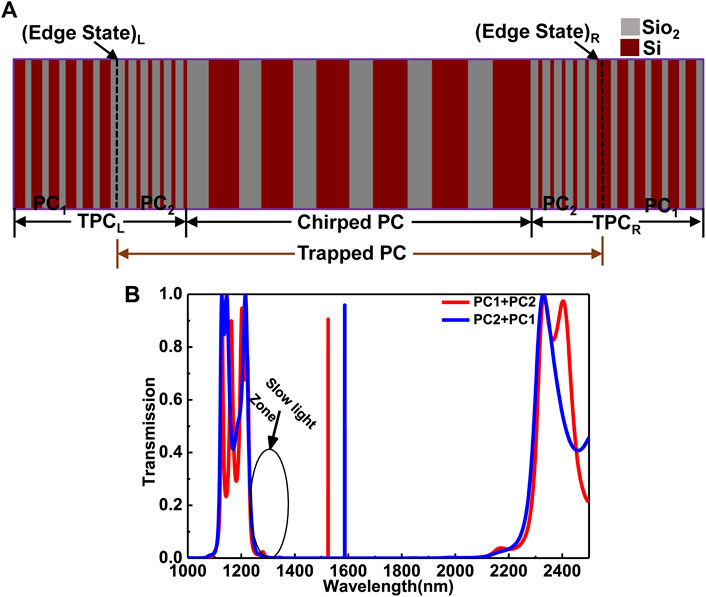- 1Key Laboratory of Advanced Optoelectronic Quantum Architecture and Measurements of Ministry of Education, Beijing Key Laboratory of Nanophotonics and Ultrafine Optoelectronic Systems, School of Physics, Beijing Institute of Technology, Beijing, China
- 2Physics Department, Faculty of Science, Assiut University, Assiut, Egypt
- 3Collaborative Innovation Center of Light Manipulations and Applications, Shandong Normal University, Jinan, China
The rainbow trapping effect has attracted gathering attention due to its potential application in data processing, energy storage, and light-matter interaction enhancement. The interest has increased recently with the advent of topological photonic crystals (PCs), as the topological PC affords a robust platform for nanophotonic devices. We proposed a chirped one-dimensional (1D) PC as a sandwiched trapped between two1D topological PCs to realize two topological edge states (TESs) for topological protection and trap the formed rainbow. Through graded the thickness of dielectric layers of the chirped 1D PC, light of different wavelengths components localizes and stores at different spatial positions leading to rainbow trapping formation. Unidirectional rainbow trapping can be observed by progressively increasing the thicknesses of the chirped PC. Nonetheless, changing increasingly one of its thicknesses and solidifying the other leads to bidirectional rainbow trapping. Achieving bidirectional rainbow trapping will reduce the footprint of nanophotonic devices in the future. This work brings inspiration to the realization of the rainbow trapping effect and provides a way to design topological nanophotonic devices.
Introduction
Photonics is principally concerned with the wave properties of frequency, wavevector, and polarization, representing the degrees of freedom of essential information for any optical system. Frequency plays an instrumental part in integrated photonic devices. In particular, it has been shown that in a tapered metamaterial structure, light can be trapped and slowed down in exact positions depending on its frequency [1]. This phenomenon is named a trapped rainbow, just as sunlight is scattered in a continuous color spectrum through a prism (hence the name is rainbow). The effect can also be considered as the spatial separation of the frequency components of the propagating wave. The appearance of rainbow trapping offers a novel technique for frequency routing of slow light [1]. After the formation of the first theoretical work, many successive methods were presented to realize rainbow trapping, such as metamaterials [1, 2], metasurfaces [3], plasmonic structures [4–6], phononic crystals in one-dimensional (1D) [7] and two-dimensional (2D) [8], and photonic crystals (PCs), in 1D [9], 2D [10, 11] and three-dimensional (3D) [12]. Most of the mentioned methods depend on either metallic or dielectric materials. However, metallic materials are lossy at optical wavelengths. Thus, the fully dielectric structure (PCs) is an excellent alternative to realizing rainbow trapping.
The rainbow trapping effect has attracted attention due to its potential applications in data processing, energy storage, and light-matter interaction enhancement. The interest has increased recently with the advent of topological PCs, which affords a robust platform for optical devices. Consequently, the combination of topology and rainbow can make possible new potentials designing topologically protected photonic devices. Due to the complex design and manufacturing structure of 2D and 3D PCs, topological PCs are preferred in the 1D structure for the advantages of simple design and ease of fabrication.
In this paper, the proposed structure is based on two-1D topological PCs to realize two topological edge states (TESs) for topological protection and trap the formed rainbow. A chirped 1D PC is inserted as a sandwiched between the two-1D topological PCs. The way to achieve the rainbow is to set the structure (or chirp) statically through one or more basic structural parameters such as position, size, and refractive index that gradually change along the direction of propagation. Through graded the thickness of dielectric layers of the chirped 1D PC, light of different wavelengths components localizes and stores at different spatial positions leading to rainbow trapping formation. The interesting observation is bidirectional rainbow trapping, increasing the thickness of one layer kind progressively and solidifying a different kind. Thus, the light propagates and localizes in both directions in the trapped area between the two TESs. Then, different frequencies can be segregated at different positions in both directions. To the best of our knowledge, this type of rainbow trapping has not been observed in topological photonics. Achieving bidirectional rainbow trapping will reduce the footprint of the nanophotonic device in the future. It is possible for this type of rainbow trapping to have numerous applications, for example, a bidirectional optical filter, a bidirectional laser, etc.
Designs and Results
The topological heterostructure of PC is based on two topological PCs, namely
A linearly chirped 1D PC is inserted as a sandwiched between the two-1D topological PCs. The chirped 1D PC is composed of six consecutive layers from
Unidirectional and Bidirectional Rainbow Trapping
As mentioned above, achieving rainbow trapping is to set the structure statically through one or more basic structural parameters that gradually change along the propagation direction. Unidirectional rainbow trapping can be observed by gradually increasing
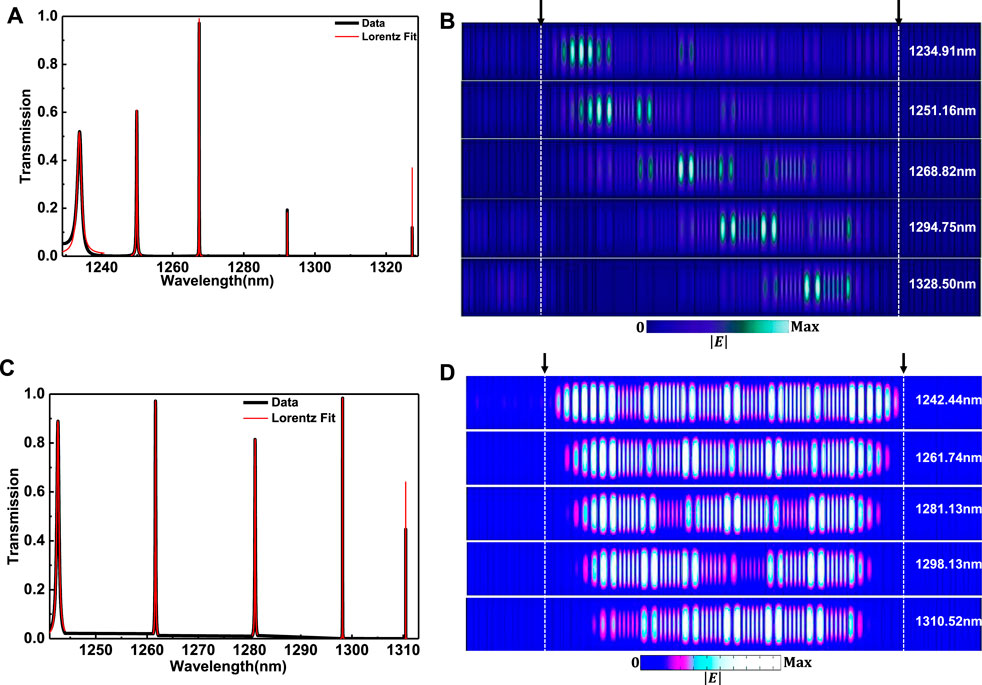
FIGURE 2. (A) The transmission spectrum of the unidirectional rainbow trapping structure with the Lorentzian-fitting curves when
To show the formed unidirectional rainbow trapping, the electric field
The work can extend to construct bidirectional rainbow trapping by progressively increasing one of its thicknesses and solidifying the other.
With increasing the number of alternative layers of the chirped PC, a higher
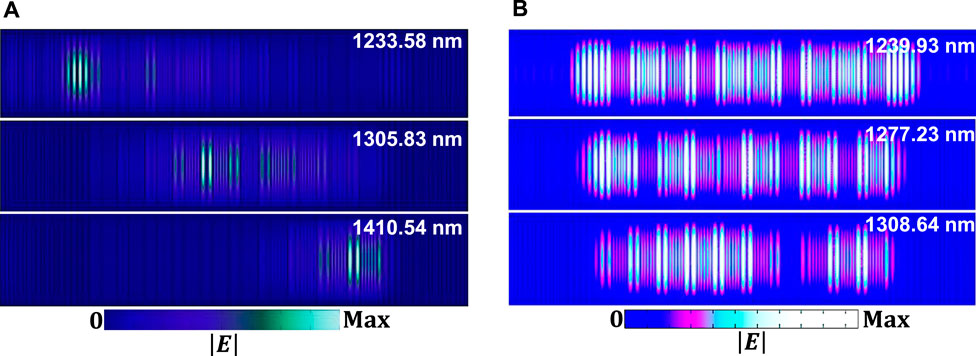
FIGURE 3. (A) The |E| intensity distribution of the unidirectional rainbow trapping at wavelengths
FDTD Validation
The proposed PC heterostructure was modeled by the finite-difference-time-domain (FDTD) method to validate the propagation properties. A high resolution (grid size for each dimension) of
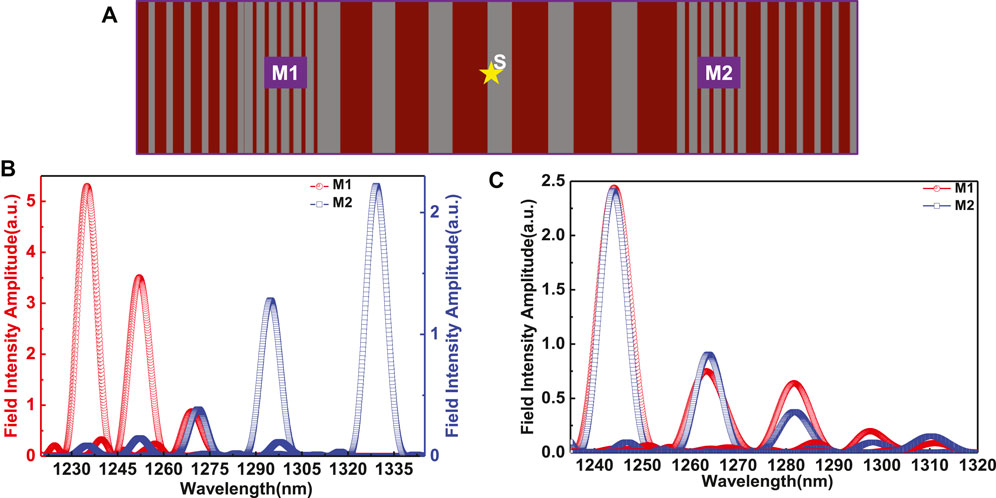
FIGURE 4. (A) FDTD set up of grid size
In the case of unidirectional rainbow trapping of
Then, to verify bidirectional rainbow trapping, the same above condition are fixed but with
Immune to Defects
The critical step is to confirm that the formed rainbow is robust and topologically protected from disorders by the two TESs on both sides. Some disorders are introduced in the trapped PC (
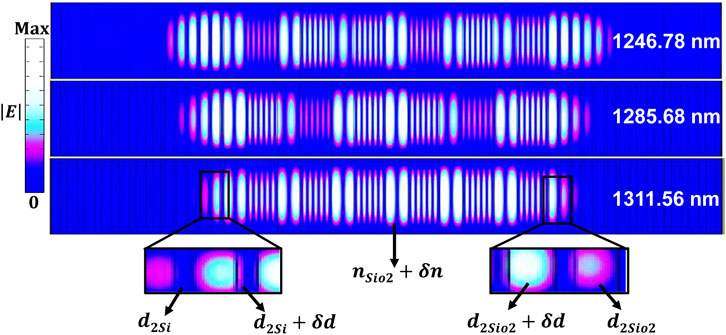
FIGURE 5. Bidirectional rainbow trapping realization with disordering of some parameters, the inset shows the deformation in last and first layers of
Trivial Rainbow Trapping
Trivial rainbow trapping is realized through the same modality by introducing a chirped PC as a trapped structure between two conventional PCs. In the exact mechanism as mentioned above, introducing a chirped PC as a sandwiched between two topological PCs (

FIGURE 6. (A) Schematic diagram of the chirped PC sandwiched between two PCs. The |E| intensity distribution of the trivial unidirectional rainbow trapping of 18 periods of the trapped chirped PC between
Unidirectional trivial rainbow trapping can be formed with the same conditions for topological cases. When
Conclusions
In conclusion, a unidirectional and bidirectional rainbow trapping have been investigated. The main idea is based on trapping a chirped PC as a sandwich between two edge states. At the same time, the two edge states work as a cavity to trap the light inside the chirped structure and can be propagated in both directions. Consequently, different frequencies from the wave packet segregate at different positions in both directions. Moreover, the propagation properties are validated using FDTD by measuring the electric field intensity amplitude. In addition, we confirmed that the formed rainbow is robust and topologically protected even in the presence of disorders. Bidirectional rainbow trapping will open a feasible way for numerous applications, e.g., multichannel wavelength demultiplexers, bidirectional optical filter, and bidirectional laser.
Data Availability Statement
The original contributions presented in the study are included in the article/Supplementary Material, further inquiries can be directed to the corresponding author.
Author Contributions
SE conceived the idea, performed the numerical simulations, and wrote the draft of the manuscript. CL checked the simulation results and revised the manuscript. CL supervised the project.
Funding
National Natural Science Foundation of China (91850117, 11654003); Beijing Institute of Technology Research Fund Program for Young Scholars.
Conflict of Interest
The authors declare that the research was conducted in the absence of any commercial or financial relationships that could be construed as a potential conflict of interest.
Publisher’s Note
All claims expressed in this article are solely those of the authors and do not necessarily represent those of their affiliated organizations, or those of the publisher, the editors and the reviewers. Any product that may be evaluated in this article, orclaim that may be made by its manufacturer, is not guaranteed or endorsed by the publisher.
References
1. Tsakmakidis KL, Boardman AD, Hess O. 'Trapped Rainbow' Storage of Light in Metamaterials. Nature (2007) 450(7168):397–401. doi:10.1038/nature06285
2. Hu H, Ji D, Zeng X, Liu K, Gan Q. Rainbow Trapping in Hyperbolic Metamaterial Waveguide. Sci Rep (2013) 3(1):1249. doi:10.1038/srep01249
3. Xu Z, Shi J, Davis RJ, Yin X, Sievenpiper DF. Rainbow Trapping with Long Oscillation Lifetimes in Gradient Magnetoinductive Metasurfaces. Phys Rev Appl (2019) 12(2):024043. doi:10.1103/PhysRevApplied.12.024043
4. Gan Q, Ding YJ, Bartoli FJ. "Rainbow" Trapping and Releasing at Telecommunication Wavelengths. Phys Rev Lett (2009) 102(5):056801. doi:10.1103/PhysRevLett.102.056801
5. Chen L, Wang GP, Gan Q, Bartoli FJ. Rainbow Trapping and Releasing by Chirped Plasmonic Waveguides at Visible Frequencies. Appl Phys Lett (2010) 97(15):153115. doi:10.1063/1.3502487
6. Schuller JA, Barnard ES, Cai W, Jun YC, White JS, Brongersma ML. Plasmonics for Extreme Light Concentration and Manipulation. Nat Mater (2010) 9(3):193–204. doi:10.1038/nmat2630
7. Chaplain GJ, De Ponti JM, Aguzzi G, Colombi A, Craster RV. Topological Rainbow Trapping for Elastic Energy Harvesting in Graded Su-Schrieffer-Heeger Systems. Phys Rev Appl (2020) 14(5):054035. doi:10.1103/PhysRevApplied.14.054035
8. Ungureanu B, Makwana MP, Craster RV, Guenneau S. Localizing Elastic Edge Waves via the Topological Rainbow Effect. Phys Rev Appl (2021) 15(1):014057. doi:10.1103/PhysRevApplied.15.014057
9. Shen Y, Fu J, Yu G. Rainbow Trapping in One-Dimensional Chirped Photonic Crystals Composed of Alternating Dielectric Slabs. Phys Lett A (2011) 375(43):3801–3. doi:10.1016/j.physleta.2011.08.023
10. Lu C, Wang C, Xiao M, Zhang ZQ, Chan CT. Topological Rainbow Concentrator Based on Synthetic Dimension. Phys Rev Lett (2021) 126(11):113902. doi:10.1103/PhysRevLett.126.113902
11. Zhang H, Qian L, Wang C, Lu C., Liu Y, Chen J, et al. Topological Rainbow Based on Graded Topological Photonic Crystals. Opt Lett (2021) 46(6):1237–40. doi:10.1364/OL.419271
12. Hayran Z, Kurt H, Staliunas K. Rainbow Trapping in a Chirped Three-Dimensional Photonic crystal. Sci Rep (2017) 7(1):3046. doi:10.1038/s41598-017-03454-w
13. Elshahat S, Abood I, Esmail MSM, Ouyang Z, Lu C. One-Dimensional Topological Photonic Crystal Mirror Heterostructure for Sensing. Nanomaterials (2021) 11(8):1940. doi:10.3390/nano11081940
14. Dal Lago V, Atala M, Foa Torres LEF. Floquet Topological Transitions in a Driven One-Dimensional Topological Insulator. Phys Rev A (2015) 92(2):023624. doi:10.1103/PhysRevA.92.023624
Keywords: rainbow trapping, topological photonic crystal, nanophotonic devices, chirped photonic crystal, topological edge state
Citation: Elshahat S and Lu C (2022) Bidirectional Rainbow Trapping in 1-D Chirped Topological Photonic Crystal. Front. Phys. 10:831203. doi: 10.3389/fphy.2022.831203
Received: 08 December 2021; Accepted: 10 January 2022;
Published: 03 February 2022.
Edited by:
Yiqi Zhang, Xi’an Jiaotong University, ChinaReviewed by:
Xiao-Dong Chen, Sun Yat-sen University, ChinaChen Shen, Rowan University, United States
Fangwei Ye, Shanghai Jiao Tong University, China
Copyright © 2022 Elshahat and Lu. This is an open-access article distributed under the terms of the Creative Commons Attribution License (CC BY). The use, distribution or reproduction in other forums is permitted, provided the original author(s) and the copyright owner(s) are credited and that the original publication in this journal is cited, in accordance with accepted academic practice. No use, distribution or reproduction is permitted which does not comply with these terms.
*Correspondence: Cuicui Lu, Y3VpY3VpbHVAYml0LmVkdS5jbg==
 Sayed Elshahat
Sayed Elshahat Cuicui Lu
Cuicui Lu